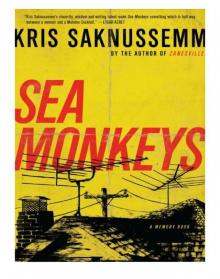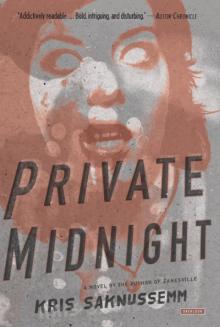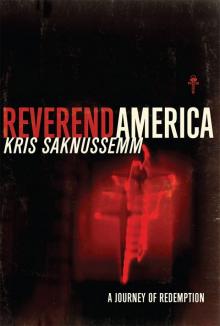- Home
- Kris Saknussemm
Sea Monkeys
Sea Monkeys Read online
Table of Contents
Title Page
Acknowledgments
TO BEGIN AT THE BEGINNING IS WHERE ALL THE TROUBLE STARTS
SIMULTANEOUS SEA LIONS
VIEW FROM THE ATTIC
SAY WHEN
NO SIMPLE SHADOWS
SUNDAY ROAST
BLUE TO LIFE
DUST MELODY
SOLDIER IN THE EGG
CALL TO WORSHIP
DON’T GET A GUN, GET A BIG DOG
THE GHOSTS AND VAN CHEESE
CUCKOO
THE EAR
SCHOOL FOR THE DEAD
I’D SHOW THEM ALL
JUMP WITH ME
LORD OF LORDS
HEAT LIGHTNING
JOSEPH COTTEN
MAD MOUSE
BAD HOMBRE
NO PRISONERS
SOMETIMES YOU MUST GET LOST MORE DEEPLY TO LEARN THE SECRET OF THE WAY OUT
THE GIFT OF EVIL
FIRE AND FORGET
JUICE IN THE PAIL
MOONLIGHT RIDER
OFF RAMP
CAPTAIN GALAXY COMES BACK TO EARTH
THE FLAMINGO CONSPIRACY
REINDEER GAMES
HAREM SCAREM
WE LIVE FOREVER
LOWERING HIM INTO THE TANK
EPICENTER
THE SHOVELER
VAT 69
AWAY GAMES
DANDELION SAFARI
LOS MURMURADORES
INDEPENDENCE NIGHT
FOOTPRINTS IN A FIELD OF ASPARAGUS
CAHOOTS
FRESH MELON
MR. VERY LATE NIGHT
EVERCLEAR
FOREVER MINE
THE RETURN OF THE SWIMMER
RUST NEEDS SOME SLEEP
POWDER MONKEYS
SENTENCED TO DISNEYLAND
HEAR THE WIND BLOW, DEAR
ONE LONG WHISTLE
THE GULF OF CALIFORNIA
ALLIGATOR WISHES
LETTERS FROM OLD GIRLFRIENDS
SEX AND DEATH
FAITH AND LIGHTNING
TO END BEFORE YOUR TIME IS WHERE ALL THE TROUBLE GROWS
HOME AWAY—RETURN TO CODA
Copyright Page
A Bowlful of Happiness—Instant Pets . . .
On the back page of a Gold Key comic book, I was promised everything I needed.
I was promised a clear acrylic ocean zoo designed like a castle, an aerating ring (whatever that was) and a water purifier. I was promised eggs and a year’s food and vitamin supply—even a growth guarantee.
There were so many promises back then. Just add water—and these longtime favorites of children and the curious come to life before your eyes.
ACKNOWLEDGMENTS
Portions of this book originally appeared in The Antioch Review, The Santa Monica Review, New Letters, Witness, Zyzzyva, The Missouri Review, The New England Review, Nimrod, Prairie Schooner, Permafrost , The Fiddlehead, The Chariton Review, The Kansas Quarterly, Gargoyle, Interim, 2Plus2, The Haight Ashbury Literary Journal, The New Mexico Humanities Review, ShatterColors Literary Review, The Nervous Breakdown, and The Age Review of Books.
I am grateful to the Black Mountain Institute of the University of Nevada, Las Vegas, and most especially to Tom E. and Mary Kay Gallagher for their generous support.
I would also like to thank my stepbrother, wherever he may be. He once told me, “The only stories you can really be sure are true are the ones you’ve forgotten.”
I have never forgotten that, and the nature of this book reflects that insight.
Lights sweep across the walls like the silhouettes of ancient animals in sacred caves.
I’m in my sister’s room—where I sleep because of my fear of the dark. Or the almost dark. Or just my fear. The peering eyes in the knots and cracks. The torture chamber in the radiator grate.
One minute you’re dragging a duffle bag through wet snow in Brussels—or ripped on tequila listening to the waves in Belize, watching a rib-skinny jaguar sniffing at rotten seaweed.
Then you’re suddenly back in your childhood bed listening to the voices in the hall—the floating hallway you never finally find yourself in, only passing through. “Shhh . . .” my sister hisses . . . trying to hear what our parents are arguing about this time. But I only remember ghost words torn from the faded yellow and vacuum tube sparkles of all those bright new tomorrow promised yesterdays . . .
Mutual of Omaha’s Wild Kingdom . . . Stand by for Action . . . Janitor in a Drum . . .
The night wind stirs the bearded spruce that dominates our tiny front yard, the blur of branches wrinkling the peppermint-striped curtains, and I close my eyes to the luminous flood ... like the Huckleberry Hound blue slides our Kenner Give-A-Show Projector casts, which I call our Give-A-Show Protector. Little rainbow windows shot through a plastic ray gun as red as Woody Woodpecker.
Glance over your shoulder, and your stepbrother is right behind you, shooting a daredevil freeway off-ramp on a ten-speed bike late at night. Look back again, and whole dog-eared decades are behind you, and a riderless Triumph motorcycle crosses the Bay Bridge. Wally Gator smears out in green cellophane ectoplasm, becoming Kim Pullman, the fat Mormon with the congenital heart defect. He only wears sweatpants and T-shirts and always smells like butter and damp dishtowels.
Squiddly Diddly and Hokey Wolf fluoresce across the ceiling of a Tudor house looking out at the blinking beacon of Alcatraz, as you step into a cinderblock basement on a hot Michigan summer night, crickets shrill in the crabgrass.
Beyond the punching bags and the hockey sticks is a closet that leads to an attic in Upstate New York—to a lowball parlor in San Jose or a cheap hotel in West Berlin. You cross the creaking planks, leaving footprints in the dust, and emerge on a street in Stratford-upon-Avon just after a freshening rain—where a woman rushing to see Shakespeare’s grave has just been run over by a double-decker bus.
Heavens to Murgatroyd. This is the green ghost glow-in-the-dark game where we tumble helplessly toward a fantastic new adventure somewhere along the infinite corridors of time.
“Shhh . . .” my sister whispers. “Pretend you’re asleep.”
The way the dead do.
TO BEGIN AT THE BEGINNING IS WHERE ALL THE TROUBLE STARTS
SIMULTANEOUS SEA LIONS
Thanks to my grandmother’s demented brother Hills (who started off with a nice idea of saving the major world headlines from the day I was born and then became a bit eclectic in his choice of stories), I know some things I might otherwise not.
For instance, on the day I was born, two sea lions that arrived in England for a display in Wellington Pier Gardens managed to escape. A local television personality known as “The Zoo Man” was injured trying to restrain one of the creatures as it “wiggled its way down the pier to freedom.”
On the same day in Toledo, Ohio, a sea lion that had escaped from a Canadian zoo was recaptured. According to a report in the New York Herald Tribune, officials of the Ontario zoo were going to dispatch a plane to take the animal back, but Toledo Zoo director Phil Skeldon, who helped make the capture in a boathouse on Sandusky Bay off Lake Erie, said he wasn’t going to give it up.
“We’re going to hold the sea lion,” he declared. “We caught it in American waters just like you would a fish, except that it’s a mammal, and we consider it ours.”
The capture followed an off-and-on chase of several days by Mr. Skeldon and other Toledo Zoo officials. On the previous evening, Mr. Skeldon was able to slow the mammal down by firing two injections of tranquilizer into its back with a carbon-dioxide-powered dart gun. On the morning of my birthday, fishermen found the sea lion browsing in a boathouse at Sandusky. Mr. Skeldon and Dan Danford, Toledo Zoo’s curator of mammals, went to the scene, an
d Mr. Danford managed to slip a noose over the mammal’s head. The men then steered the sea lion to a raft, got it into a cage, and brought it back to Toledo in a station wagon.
So a noose is slipped around the head of one sea lion on the lam, and an umbilical cord is cut, releasing another amphibious mammal into the light. At least I wasn’t taken to Toledo in a station wagon. No comets were seen on that, my first official day, but dense, traffic-endangering fog enveloped the city of Melbourne, Australia, a heavy earth shock was recorded in El Salvador and an eighteen-inch section of tailpipe fell from an airplane, narrowly missing seven-year-old Joseph Lamond playing peacefully in his Long Island front yard.
The stock market was up for the third day in a row. Chicago egg futures looked bright. But what of the future? I took my first violent breath, and Dr. Rafael Taubenschlag, director of the Warsaw Institute of Papyrology, took his last, killing himself in Krakow at age seventy-seven. Hours later, a famous atomic scientist was found dead of an overdose of sleeping pills in Texas, along with a suicide note he’d written to his wife. “I see no other way out. I cannot bear to go back to the laboratory. So many things undone that I should have done. So many decisions to make that I do not feel capable of making.”
Good old Great Uncle Hills. He certainly had an eye for the positive, uplifting stories. Like the fate of the Cocoa, one of three jet tanker planes attempting to break the speed record from New York to London, which while taking off from Westover Air Force Base hit high-tension wires and smashed down onto the Massachusetts Turnpike, skidding onto the three-acre farm of Kazimierz Machowski, where its tons of kerosene fuel ignited. Among the fifteen men killed instantly was Norman J. Montellier of New York, age thirty-seven, a UPI writer.
I guess you’d have to say it wasn’t a very good day for Polish experts on Egyptian papyruses, atomic scientists or foreign affairs writers from Queens.
You could buy a quart of Astor’s All-American Vodka for $4.69 or a new Chrysler for $2,275. In America, the only thing more prevalent than prosperity was Doom—and Doom was big business. In drive-ins across the country, people still gobbled Good & Plenty during the intermission between The Thing That Couldn’t Die and The Day the World Ended, while teenagers faced the shocking facts about grave robbers from outer space. Got your Baby Bee motor airplane or your sun-powered eyeglass hearing aids yet? What’s your story about tonight, old Ranger?
While you were watching TV, you could read about Aldo Danesi, who was injured in a freak garage door accident, or the retired Japanese strawberry grower who was killed by a train on his own property in Coyote, California.
Sandra Lee Jennings of Riverside, “a leggy, lovely honey blonde with stars in her big blue eyes,” walked off with the Miss California Crown, while a potent chemical known as LSD-25, which quickly releases long-repressed memories and unconscious emotional conflicts, is found to be dramatically helpful in speeding the treatment of mental disease. There’s a panel discussion on the wonder drug at the annual American Medical Association meeting, where Crisada, Salvador Dali’s 2½-ton, sixty-foot-long artistic contribution, depicts “the caterpillar of man’s anxiety contemplating becoming the butterfly of human tranquility.”
At the same convention, Dr. Herbert Ratner, public health director of Oak Park, Illinois, laments the widespread breast neuroticism. “Everyone pays lip service to the breasts but the baby,” he says. “By default, the subordinate function of the breasts—to add to a woman’s beauty and attractiveness—has pre-empted the primary function and has taken on artificial, excessive and idolatrous dimensions.”
That night, the live broadcast of eight-year-old Tommy Hunter’s open-heart surgery beats out Cheyenne in the ratings. The next morning, there are more sightings of sea lions in Lake Erie. Only one gets verified. It proves to be the body of a furniture upholsterer from Vermillion, Ohio, named Fritz Buchenwald.
Mr. Buchenwald’s empty boat was later recovered off Marblehead, drifting in the direction of Kelleys Island. An autopsy revealed the cause of death was actually not drowning, although it was clear that the upholsterer had fallen out of his aluminum dinghy. Apparently the man had choked on a sandwich made with Underwood Deviled Ham. A further curious element was that although he was an avid fisherman, it seems he had not taken any of his fishing gear with him. According to Benjamin Cutley, one of his friends, the deceased, who was a widower and had no children, “had looked sort of worried of late, as if he had something important on his mind that he needed to work out.”
Perhaps that’s what he was trying to do alone out in his boat. Another mystery.
Why does one sea lion wiggle its way down the pier to freedom while another gets drugged, noosed and escorted by administrative officials back to Toledo?
What was so important that Fritz Buchenwald needed to mull over? Had he reached a decision when he reached for that sandwich?
VIEW FROM THE ATTIC
The way my mother tells it, there were weekend trips to her uncle’s farm to drink buttermilk and to swat flies. “He was an angry man in suspenders,” she mutters. And that’s all she ever says.
But her sister let slip once, before one of her six operations, that one Christmas Eve, he swallowed a glass of eggnog and hanged himself from a hay hook while the choir went door to door singing “Good King Wencesias.”
The part I really love, though, is that he was discovered by the pretty “mulatto” housekeeper he’d fired suddenly a week before. Imagine. What errand could possibly have drawn her into the hostile shadow of that silo at that exact moment?
We all have our theories. We never speak of them. We never even acknowledge that there are only so many theories to be had. The funny thing to me is that it all seems so clear. I can fool myself into believing I can actually see that moment in the past—the truth of it, I mean. The small-town repertory and the seasons that moved them.
That’s why we cling to our family legends. Because they don’t tell stories. They almost tell stories. They leave us with eggnog and questions, and sometimes, if we’re very lucky, an absurd Christmas carol or a second set of footprints, and we go from there.
SAY WHEN
My father lifted me onto his lap as if he intended to tell me one of his growing-up stories. Black Rock Desert, Nevada.
Then he pressed the pedal to the floor—a sudden sound like a man crushing sand between his teeth.
My hands seized the shimmying wheel when he let go, blue air burning by across the vast salt mirror. The arrow trembled to 100, and my mother closed her eyes, singing for him to stop.
But it was a moment in me he was searching for, so there was no stopping—me steering straight for the vanishing lakes—a point in time only I could recognize, having never been there before.
NO SIMPLE SHADOWS
No doubt the mysterious observer is paused in the fringe of shadow for some good reason. Maybe simply not wanting to invade the family portrait. Yet this unidentified interloper distinctly draws the eye away from the four posed people in the central foreground. He’s frozen with clenched hands at his side and looks to be somewhere near my father’s age, so perhaps he’s a buddy or a neighbor. But it’s odd the way his upper body and especially his face recedes into shadow, mottling his white T-shirt so that he appears intermittent, his torso intermingling with the light and leaves.
The picture is in black-and-white. The tree is a graceful maple, curiously black, like the space where a tree used to be. In contrast, the family on the bench seems that much brighter. The three from the left are mainly dressed in white. My father, who is perhaps sixteen, wears a white shirt and cuffed dark pants that look comfortable. He’s thin of face and lean of body, with dark hair and a high forehead. He has one arm resting on his knee and the other (of course) wrapped around the shoulder of his mother, who years later my sister and I will call Gaja. She has a regrettably large nose and an ill-advised haircut—a wavy flattened bob with shoots out to the side resembling epaulettes. Beside her is my grandfather Karl. He doesn’t ap
pear the way I expect, no matter how often I look, even though the maple tree is usually the same.
West Mountain Road in Ridgefield, Connecticut. It’s a rundown farm property then, in the early 1940s. I see old fruit trees and a pile of logs and planks behind them. The grass is neat under their feet although it’s overgrown in the lot beyond, where there are bee boxes stacked up near a tepee-shaped incinerator. Grandfather Karl looks tense. His face is already lined, two sharp troughs running like scars down his prominent cheekbones. Two other lines run over each eyebrow, as if thumbs have been pressed permanently hard into the skin. Across his forehead is another furrow. It gives his face a worn, wasted cast. He has one shoulder slightly turned and is much wirier than I imagined. Both his oversized hands are entwined in the silky hair of their water spaniel–Irish setter cross that sits between his knees. His expression is frustrated and impatient.
My teenage father (a virgin then), closer than he realizes to war and the Alps of Italy, clings to his mother protectively. She sits solidly between father and son, pleasant, maternally calm. A bastion . . . as she will be later in our family in California.
Aunt Angelou is the fourth occupant of the bench. She has on saddle shoes and white ankle socks and is wearing a rather pretty plaid dress. Her brown hair is shoulder length and she is biting her lip in an awkward smile that looks like she’s trying to suppress a giggle. It’s somehow obvious in a way that can’t quite be identified that there’s something not right about her. Simple is the word that gets used later.
Another picture. My sister and I are sitting at the drop-leaf table in the Berkeley dining room under the solemn stare of the Japanese woman hanging on the wall as I learn the secrets of transferring to my napkin unwanted portions of carrots and brussels sprouts. Angelou is there with her husband, Dwayne, who is just out of frame. She works as a convalescent hospital nurse (doesn’t sound simple to me). Dwayne has something to do with teaching languages for the military but he’s really a military historian with family money (rumors of diamond mines and missionaries given over to bad behavior). He’s what Gaja calls an odd duck. He speaks like someone important, his deep voice rising out of a cannon-shaped hole where his face should be . . . only the suggestion of a moustache and shining spectacles occasionally glint through the black halo of his baritone. Yet he’s strangely devoted to Angelou, taking her on adventures to East Africa and the Congo . . . riding elephants in Thailand . . . Scottish hunting lodges filled with horns and hooves. In one of the pictures of her in the Indonesian archipelago, she stands in tall grass wearing khakis and a pith helmet. Approaching from behind is a Komodo dragon.

 The Humble Assessment
The Humble Assessment Sea Monkeys
Sea Monkeys Private Midnight
Private Midnight Reverend America: A Journey of Redemption
Reverend America: A Journey of Redemption Zanesville: A Novel
Zanesville: A Novel